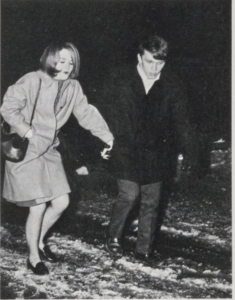The traditional social system we entered in 1964 sounds medieval to today’s young, but at the time it still generally reflected the rules parents expected single-sex educational institutions to establish and administer for their supposedly grownup children. In loco parentis ruled.
As freshmen, although we were addressed in the classroom with the grownup title of “Mister,” we were, paradoxically, subjected to rigid social controls in the form of parietal dorm rules throughout our undergraduate years, even after many of us had attained the age of 21 in our senior year. The message to us was clear: at your age, you cannot yet be trusted to make good decisions regarding sexual matters. The system was designed as much to protect the reputation of the educational institution as the well-being of the student, and also to protect visiting women students and the female-only educational institutions they attended, which operated in the same social network of single-sex schools.
Our JAs were supposed to monitor us to ensure compliance. The rules restricted visiting hours for women, although, if memory services, the hours eventually ran until 2 am for upperclassmen. Freshman year, however, the latest curfew was midnight; this was restricted to the first floor, and it was only allowed on big weekends like homecoming and Winter Carnival, if memory serves.
To protect women at neighboring “girls’ schools,“ the controls were even more pervasive-enforced by a reception desk staffed by a student in each dorm or house, a resident housemother, a total ban on male visitors in rooms, and a sign-out system when leaving campus. There were some limited visiting hours for males in the rooms of women at some point after freshman year, however.
Of course, during our college years, hormonal urges caused some to circumvent the rules, sometimes quite ingeniously. At all the New England colleges, disciplinary committees heard parietals violation cases and administered punishments
Despite this system, rumors spread on campus from time to time about women living surreptitiously in one residential house or another—for up to a semester, even. Our college years coincided with the dwindling years of this hoary system. By the end of the sixties and into the seventies these longstanding social conventions waned in higher education as students asserted their rights, authority was successfully challenged, coeducation became the norm, and sexual norms throughout society changed.

